牛津译林版7b unit 5 grammar 课件 (共40张PPT)
文档属性
| 名称 | 牛津译林版7b unit 5 grammar 课件 (共40张PPT) | 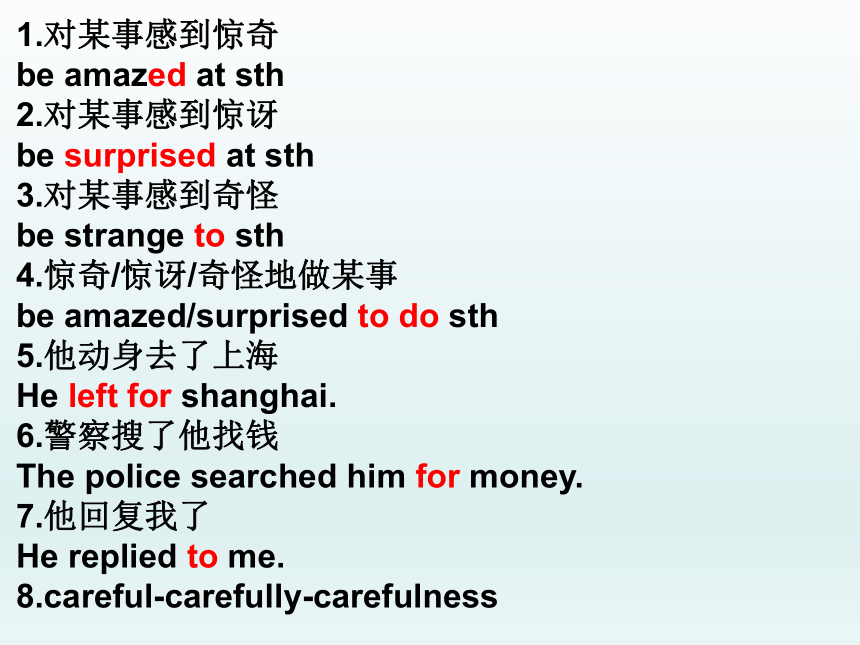 | |
| 格式 | zip | ||
| 文件大小 | 231.4KB | ||
| 资源类型 | 教案 | ||
| 版本资源 | 牛津译林版 | ||
| 科目 | 英语 | ||
| 更新时间 | 2018-04-08 14:09:55 | ||
图片预览

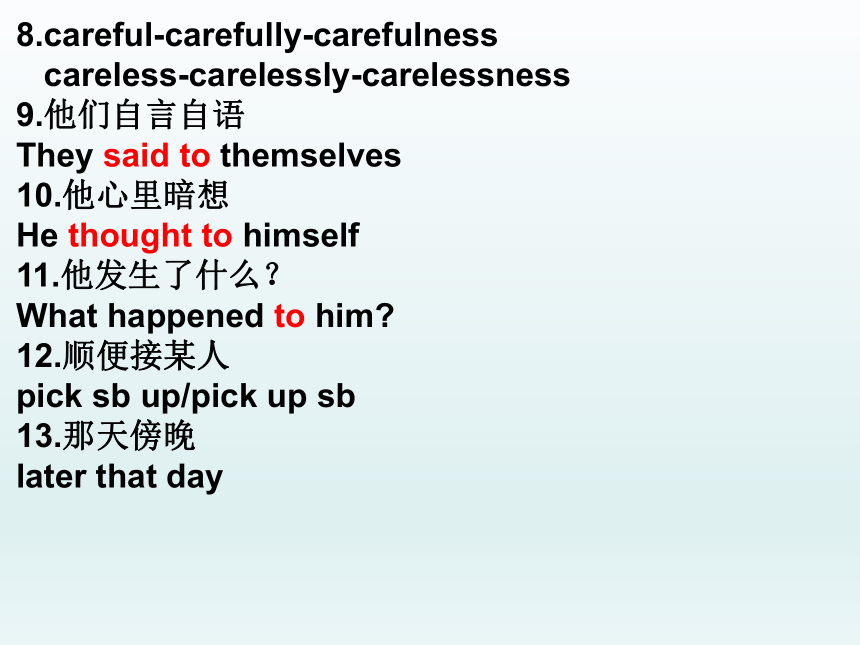
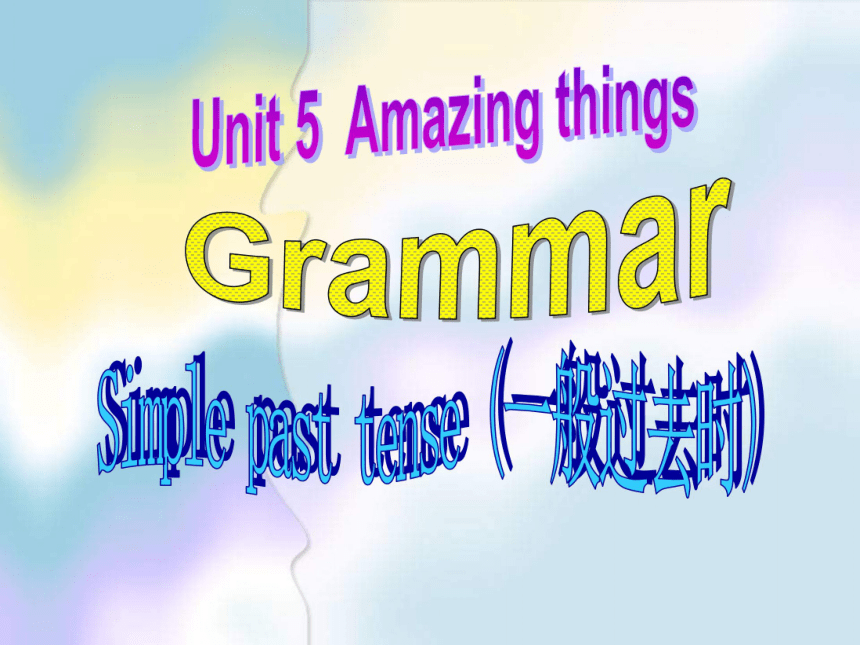
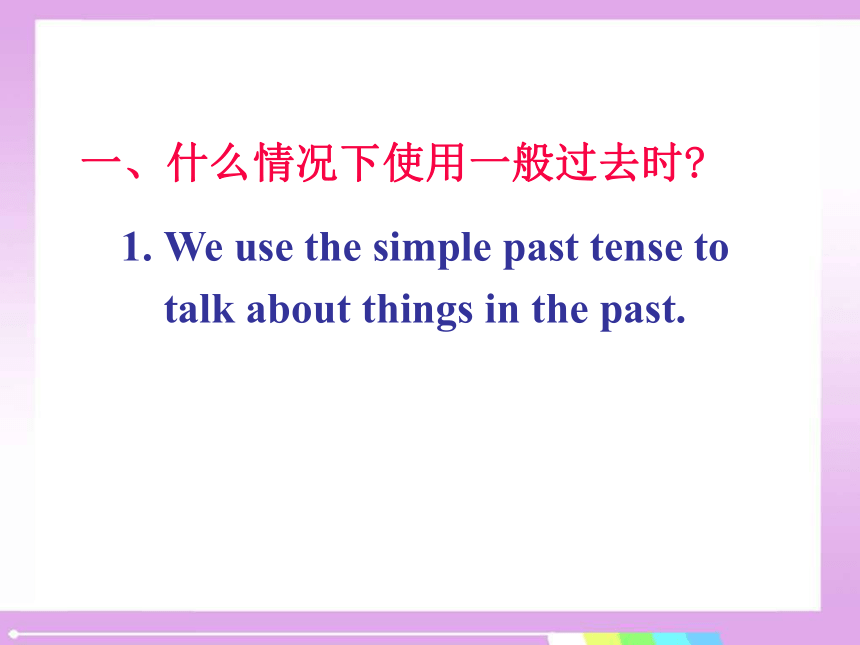
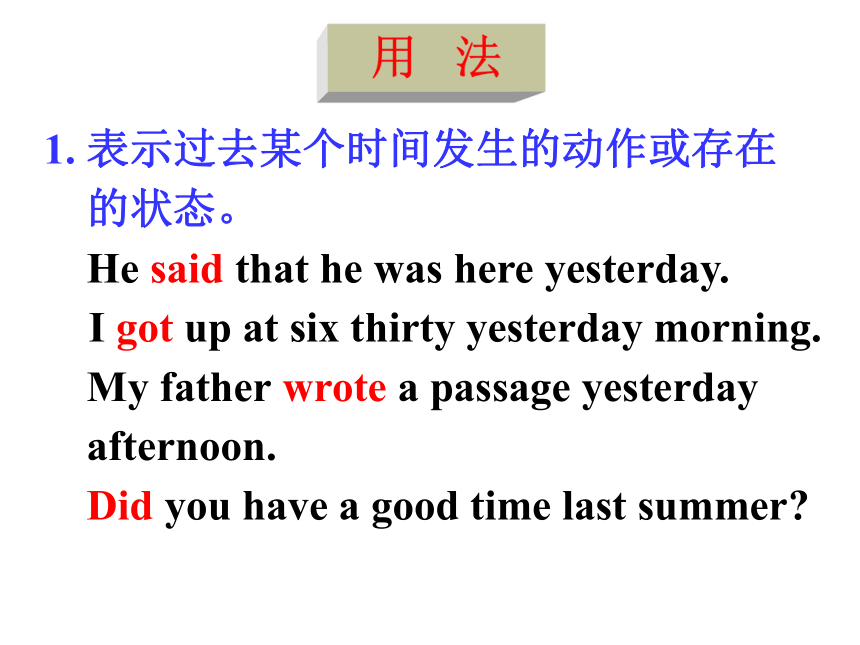

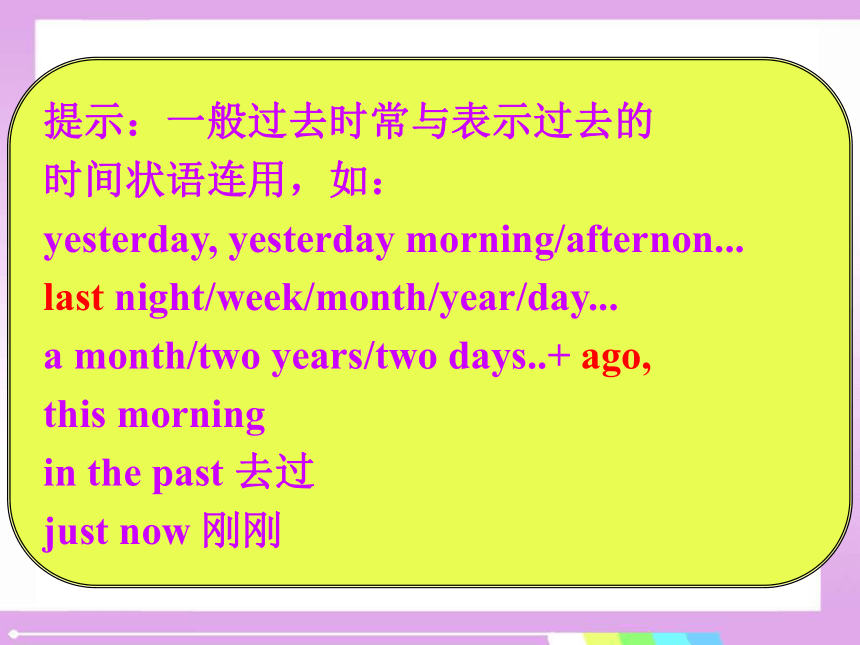
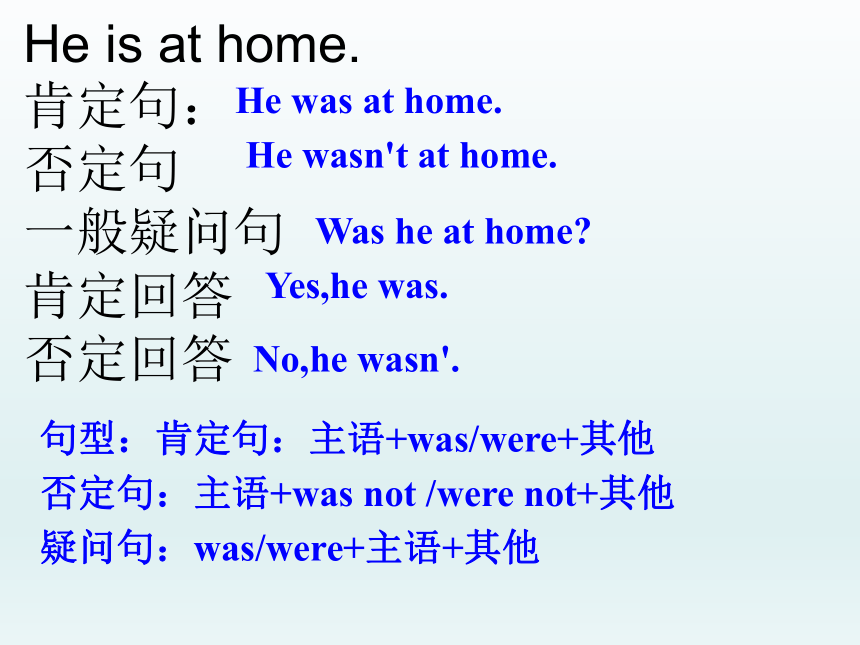
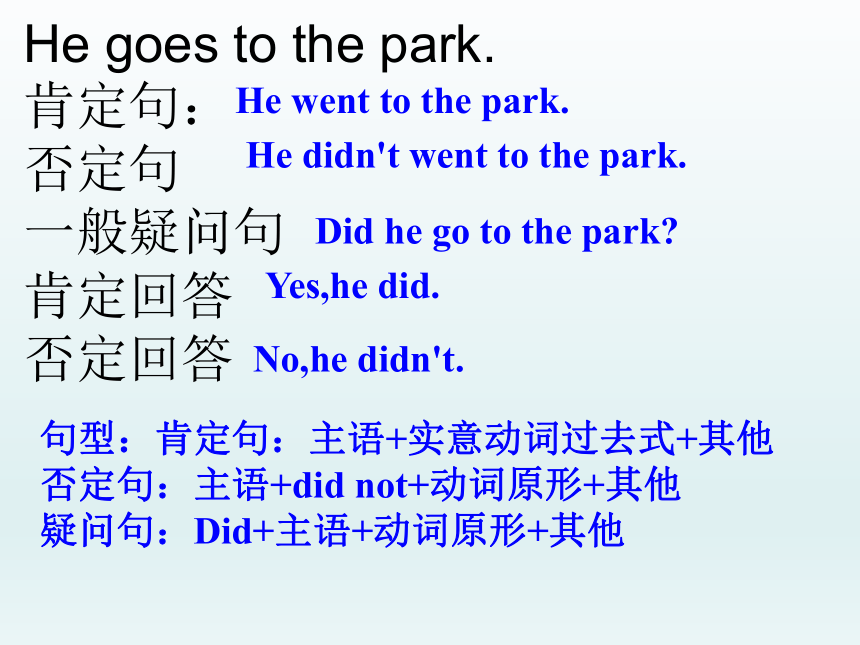
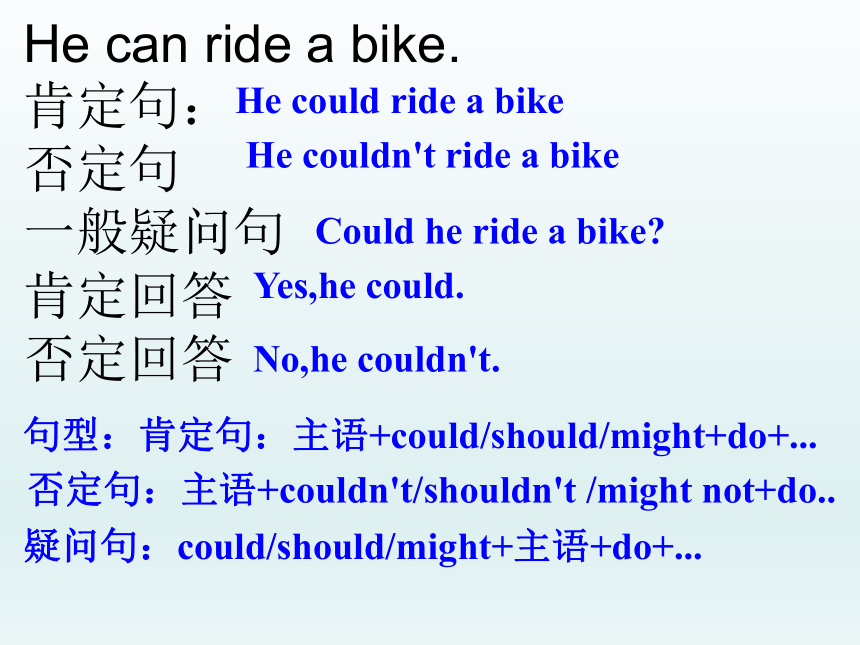
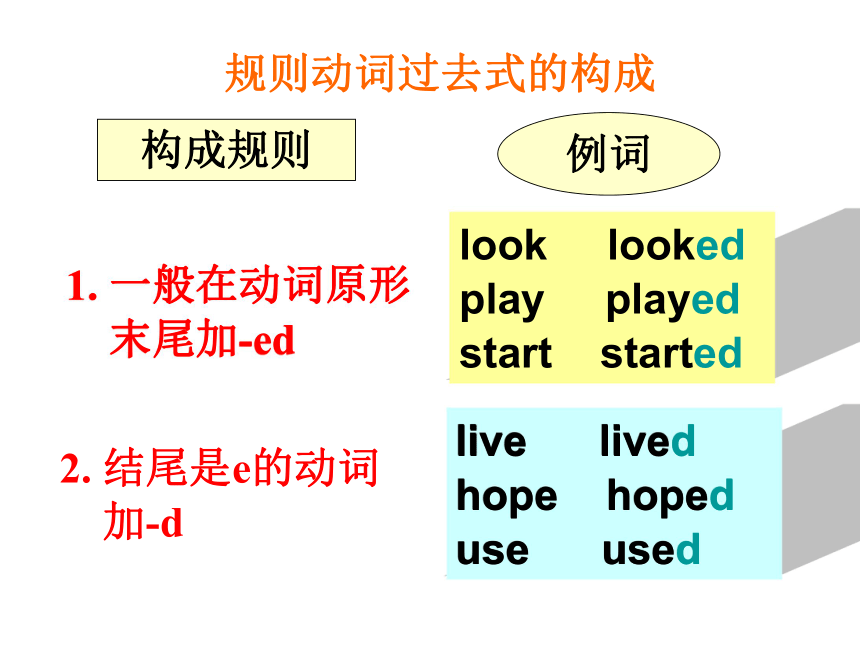
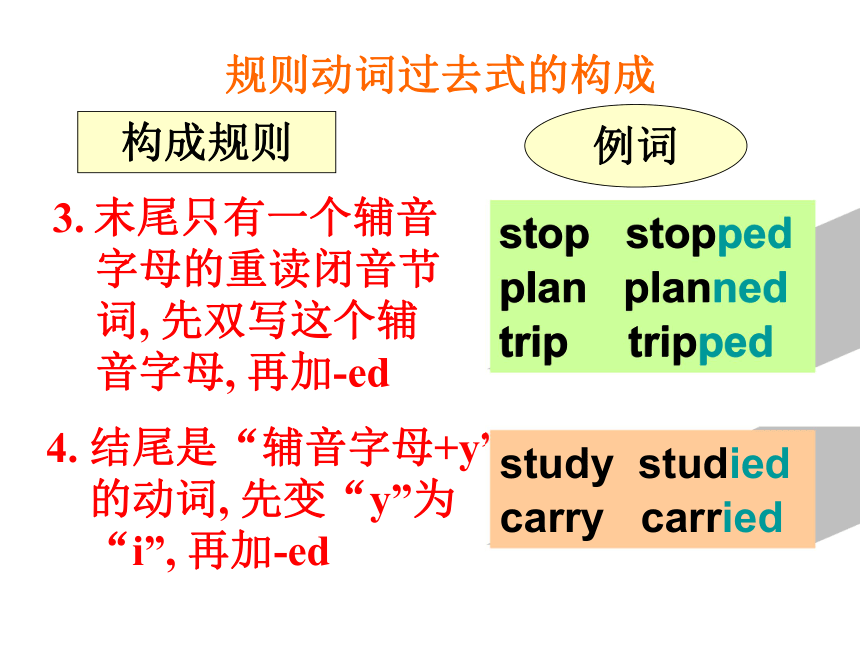
文档简介
课件40张PPT。1.对某事感到惊奇
be amazed at sth
2.对某事感到惊讶
be surprised at sth
3.对某事感到奇怪
be strange to sth
4.惊奇/惊讶/奇怪地做某事
be amazed/surprised to do sth
5.他动身去了上海
He left for shanghai.
6.警察搜了他找钱
The police searched him for money.
7.他回复我了
He replied to me.
8.careful-carefully-carefulness8.careful-carefully-carefulness
careless-carelessly-carelessness
9.他们自言自语
They said to themselves
10.他心里暗想
He thought to himself
11.他发生了什么?
What happened to him?
12.顺便接某人
pick sb up/pick up sb
13.那天傍晚
later that dayUnit 5 Amazing thingsGrammarSimple past tense (一般过去时)We use the simple past tense to talk about things in the past.一、什么情况下使用一般过去时?用 法 表示过去某个时间发生的动作或存在
的状态。
He said that he was here yesterday.
I got up at six thirty yesterday morning.
My father wrote a passage yesterday
afternoon.
Did you have a good time last summer?2. 表示过去经常或反复发生的动作。
My father often went to work by
bus last year.
When I was a child, I often listened
to music.提示:一般过去时常与表示过去的
时间状语连用,如:
yesterday, yesterday morning/afternon...
last night/week/month/year/day...
a month/two years/two days..+ ago,
this morning
in the past 去过
just now 刚刚He is at home.
肯定句:
否定句
一般疑问句
肯定回答
否定回答He was at home.He wasn't at home.Was he at home?Yes,he was.No,he wasn'.句型:肯定句:主语+was/were+其他否定句:主语+was not /were not+其他疑问句:was/were+主语+其他He goes to the park.
肯定句:
否定句
一般疑问句
肯定回答
否定回答He went to the park.He didn't went to the park.Did he go to the park?Yes,he did.No,he didn't.句型:肯定句:主语+实意动词过去式+其他
否定句:主语+did not+动词原形+其他
疑问句:Did+主语+动词原形+其他He can ride a bike.
肯定句:
否定句
一般疑问句
肯定回答
否定回答He could ride a bikeHe couldn't ride a bikeCould he ride a bike?Yes,he could.No,he couldn't.句型:肯定句:主语+could/should/might+do+...疑问句:could/should/might+主语+do+...否定句:主语+couldn't/shouldn't /might not+do..规则动词过去式的构成构成规则例词2. 结尾是e的动词
加-d1. 一般在动词原形
末尾加-edlive lived hope hoped use usedlook looked play played start started规则动词过去式的构成构成规则例词3. 末尾只有一个辅音
字母的重读闭音节
词, 先双写这个辅
音字母, 再加-ed stop stopped
plan planned
trip tripped4. 结尾是“辅音字母+y”
的动词, 先变“y”为
“i”, 再加-ed study studied
carry carried提示: 以元音字母+y结尾的动词
按第一条规则,即:+ed,
如: stay —stayed 三、不规则动词的过去式不是加ed 构成的, 需要我们记住它们。不规则动词的过去式归纳起来有这样几种类型(见下表):原形 过去式
cost
cut
read
hit
let
hurt
put
set
shut
cost
cut
read
hit
let
hurt
put
set
shut1.与原形一样,没有变化原形 过去式
come
begin
become
draw
drink
drive
fall
forget
get
came
began
became
drew
drank
drove
fell
forgot
got
2.改变一个元音字母原形 过去式
give
hold
know
grow
ride
ring
rise
run
sing
gave
held
knew
grew
rode
rang
rose
ran
sang
2.改变一个元音字母原形 过去式
swim
throw
wake
win
lose
dig(挖)
hang(悬挂)
sit
stick(粘贴)
swam
threw
woke
won
lost
dug
hung
sat
stuck2.改变一个元音字母原形 过去式
build
lend
send
spend
built
lent
sent
spent3.改变一个辅音字母原形 过去式
break
speak
write
wear
bear(忍受)
broke
spoke
wrote
wore
bore4.其他不规则变化原形 过去式
bring
buy
find
teach
catch
fight
plan
stop
shop
chat
travel
brought
bought
found
taught
caught
fought
planned
stopped
shopped
chatted
travelled原形 过去式
be
choose(选择)
do
dream
mean
learn
eat
feed(喂养)
meet
was/were
chose
did
dreamt
meant
learnt/learned
ate
fed
met4.其他不规则变化原形 过去式
feel
keep
sleep
smell
spell
fly
go
have
hear
felt
kept
slept
smelt
spelt
flew
went
had
heard4.其他不规则变化原形 过去式
lay(放置)
leave
lie(躺)
lie(撒谎)
light(点燃)
take
pay
say
see
laid
left
lay
lied
lit
took
paid
said
saw4.其他不规则变化原形 过去式
sell
shine
stand
steal(偷)
understand
wear
can
may
shall
will
sold
shone
stood
stole
understood
wore
could
might
should
would
4.其他不规则变化清念 /t/, 元浊/d/;
/t/ /d/ 之后念/id/规则动词+-ed的读音说明:
清念 /t/,即 ed 在清辅音后面念
/t/,例:
finished helped passed
cooked
2. 元浊 /d/,即 ed 在元音,浊辅音后
面念 /d/,例:
borrowed enjoyed called
moved 说明:
3. /t/ /d/ 之后念 /id/,即 ed 在 /t/ /d/
音后面念 /id/,例:
wanted shouted needed
counted肯定句
主语+谓语动词过去式……
He hears a whisper.
---He heard a whisper.四、谓语动词为实义动词的一般过去时的句子结构2) 否定句
主语 + didn’t +谓语动原形 ……
I go to the park yesterday morning.
I didn't go to the park yesterday morning. 3)一般疑问句
Did +主语+谓语动原形……?
Yes, 代词+did. / No, 代词+ didn’t.
Did you go to the park yesterday morning?
Yes, I did.
Did he hear a whisper?
No, he didn’t. start ______
love _________
play ______
plan ______9. leave _____
10. tell _____
11. stand _____
12. bring ______5. reply _____
6. say ________
7. meet _____
8. hear ______startedplayedlovedplannedsaidrepliedleftmetstoodtoldheardbroughtPRACTISEFinish Part A on page 62.She waits for me.He watches TV.Micky dances happily.He plays basketball.She goes to school.Do more exercises.She waited for me.He watched TV.He played basketball.Micky danced happily.She went to school.1. Lucy did her homework at home.(改否定句)
Lucy ______ ___ her homework at home.
2. He found some meat in the fridge. (变一般疑问句)
____ he ____ ____ meat in the fridge?
3. She stayed there for a week. (对划线部分提问)
____ ____ ___ she ____ there?
4. There was some orange in the cup. (变一般疑问句)
_____ there ___ orange in the cup? didn’t do
Did find any
How long did stay
Was any改写句子。This morning, we _____ (go) to the Fun World Museum. When we ____ (get) to the museum, there _____ (be) a lot of people there. We _____ (spend) three hours in the museum. I ____ (take) a lot of photos. Some of us _______ (buy) cards of the animals there. We _____ (come) back to school at 1 p.m. We ____ (have) a great time!wentwerespenttookboughtcamehadgotFinish Part B on page 62.Millie: We _____ (go) to the Fun World Museum
the day before yesterday, Daniel. It ____
(be) so interesting!
Daniel: Really? Tell me all about it.
Millie: OK. We ____ (see) a small monkey, only
11 centimetres tall.
Daniel: That’s amazing! What else?
Millie: We also _____ (learn) about some
strange birds like dodos. They _____ (live)
on the earth a long time ago.
Daniel: That’s cool!wentsawwaslearntlivedFinish Part C on page 62.今天早上
到达博物馆
拍了很多照片
动物的卡片
回到学校
告诉我关于它的所有的事
11厘米高
住在地球上
很久以前 this morning
get to the museum
take a lot of photos
cards of animals
come back to school
tell me all about it
11 centimetres tall
live on the earth
a long time ago
巧记动词过去时态动词一般过去时,表示过去发生的事;
be用was或用were, have, has变had;
谓语动词过去式,过去时间做标志;
一般动词加-ed,若是特殊得硬记。
否定句很简单,主语之后didn’t添;
疑问句也不难,did放在主语前;
如果谓语之前有did,谓语动词需还原;
动词若是was, were, 否定就把not添。Homework1. Learn the irregular verbs by heart.
2. Do some translations.
be amazed at sth
2.对某事感到惊讶
be surprised at sth
3.对某事感到奇怪
be strange to sth
4.惊奇/惊讶/奇怪地做某事
be amazed/surprised to do sth
5.他动身去了上海
He left for shanghai.
6.警察搜了他找钱
The police searched him for money.
7.他回复我了
He replied to me.
8.careful-carefully-carefulness8.careful-carefully-carefulness
careless-carelessly-carelessness
9.他们自言自语
They said to themselves
10.他心里暗想
He thought to himself
11.他发生了什么?
What happened to him?
12.顺便接某人
pick sb up/pick up sb
13.那天傍晚
later that dayUnit 5 Amazing thingsGrammarSimple past tense (一般过去时)We use the simple past tense to talk about things in the past.一、什么情况下使用一般过去时?用 法 表示过去某个时间发生的动作或存在
的状态。
He said that he was here yesterday.
I got up at six thirty yesterday morning.
My father wrote a passage yesterday
afternoon.
Did you have a good time last summer?2. 表示过去经常或反复发生的动作。
My father often went to work by
bus last year.
When I was a child, I often listened
to music.提示:一般过去时常与表示过去的
时间状语连用,如:
yesterday, yesterday morning/afternon...
last night/week/month/year/day...
a month/two years/two days..+ ago,
this morning
in the past 去过
just now 刚刚He is at home.
肯定句:
否定句
一般疑问句
肯定回答
否定回答He was at home.He wasn't at home.Was he at home?Yes,he was.No,he wasn'.句型:肯定句:主语+was/were+其他否定句:主语+was not /were not+其他疑问句:was/were+主语+其他He goes to the park.
肯定句:
否定句
一般疑问句
肯定回答
否定回答He went to the park.He didn't went to the park.Did he go to the park?Yes,he did.No,he didn't.句型:肯定句:主语+实意动词过去式+其他
否定句:主语+did not+动词原形+其他
疑问句:Did+主语+动词原形+其他He can ride a bike.
肯定句:
否定句
一般疑问句
肯定回答
否定回答He could ride a bikeHe couldn't ride a bikeCould he ride a bike?Yes,he could.No,he couldn't.句型:肯定句:主语+could/should/might+do+...疑问句:could/should/might+主语+do+...否定句:主语+couldn't/shouldn't /might not+do..规则动词过去式的构成构成规则例词2. 结尾是e的动词
加-d1. 一般在动词原形
末尾加-edlive lived hope hoped use usedlook looked play played start started规则动词过去式的构成构成规则例词3. 末尾只有一个辅音
字母的重读闭音节
词, 先双写这个辅
音字母, 再加-ed stop stopped
plan planned
trip tripped4. 结尾是“辅音字母+y”
的动词, 先变“y”为
“i”, 再加-ed study studied
carry carried提示: 以元音字母+y结尾的动词
按第一条规则,即:+ed,
如: stay —stayed 三、不规则动词的过去式不是加ed 构成的, 需要我们记住它们。不规则动词的过去式归纳起来有这样几种类型(见下表):原形 过去式
cost
cut
read
hit
let
hurt
put
set
shut
cost
cut
read
hit
let
hurt
put
set
shut1.与原形一样,没有变化原形 过去式
come
begin
become
draw
drink
drive
fall
forget
get
came
began
became
drew
drank
drove
fell
forgot
got
2.改变一个元音字母原形 过去式
give
hold
know
grow
ride
ring
rise
run
sing
gave
held
knew
grew
rode
rang
rose
ran
sang
2.改变一个元音字母原形 过去式
swim
throw
wake
win
lose
dig(挖)
hang(悬挂)
sit
stick(粘贴)
swam
threw
woke
won
lost
dug
hung
sat
stuck2.改变一个元音字母原形 过去式
build
lend
send
spend
built
lent
sent
spent3.改变一个辅音字母原形 过去式
break
speak
write
wear
bear(忍受)
broke
spoke
wrote
wore
bore4.其他不规则变化原形 过去式
bring
buy
find
teach
catch
fight
plan
stop
shop
chat
travel
brought
bought
found
taught
caught
fought
planned
stopped
shopped
chatted
travelled原形 过去式
be
choose(选择)
do
dream
mean
learn
eat
feed(喂养)
meet
was/were
chose
did
dreamt
meant
learnt/learned
ate
fed
met4.其他不规则变化原形 过去式
feel
keep
sleep
smell
spell
fly
go
have
hear
felt
kept
slept
smelt
spelt
flew
went
had
heard4.其他不规则变化原形 过去式
lay(放置)
leave
lie(躺)
lie(撒谎)
light(点燃)
take
pay
say
see
laid
left
lay
lied
lit
took
paid
said
saw4.其他不规则变化原形 过去式
sell
shine
stand
steal(偷)
understand
wear
can
may
shall
will
sold
shone
stood
stole
understood
wore
could
might
should
would
4.其他不规则变化清念 /t/, 元浊/d/;
/t/ /d/ 之后念/id/规则动词+-ed的读音说明:
清念 /t/,即 ed 在清辅音后面念
/t/,例:
finished helped passed
cooked
2. 元浊 /d/,即 ed 在元音,浊辅音后
面念 /d/,例:
borrowed enjoyed called
moved 说明:
3. /t/ /d/ 之后念 /id/,即 ed 在 /t/ /d/
音后面念 /id/,例:
wanted shouted needed
counted肯定句
主语+谓语动词过去式……
He hears a whisper.
---He heard a whisper.四、谓语动词为实义动词的一般过去时的句子结构2) 否定句
主语 + didn’t +谓语动原形 ……
I go to the park yesterday morning.
I didn't go to the park yesterday morning. 3)一般疑问句
Did +主语+谓语动原形……?
Yes, 代词+did. / No, 代词+ didn’t.
Did you go to the park yesterday morning?
Yes, I did.
Did he hear a whisper?
No, he didn’t. start ______
love _________
play ______
plan ______9. leave _____
10. tell _____
11. stand _____
12. bring ______5. reply _____
6. say ________
7. meet _____
8. hear ______startedplayedlovedplannedsaidrepliedleftmetstoodtoldheardbroughtPRACTISEFinish Part A on page 62.She waits for me.He watches TV.Micky dances happily.He plays basketball.She goes to school.Do more exercises.She waited for me.He watched TV.He played basketball.Micky danced happily.She went to school.1. Lucy did her homework at home.(改否定句)
Lucy ______ ___ her homework at home.
2. He found some meat in the fridge. (变一般疑问句)
____ he ____ ____ meat in the fridge?
3. She stayed there for a week. (对划线部分提问)
____ ____ ___ she ____ there?
4. There was some orange in the cup. (变一般疑问句)
_____ there ___ orange in the cup? didn’t do
Did find any
How long did stay
Was any改写句子。This morning, we _____ (go) to the Fun World Museum. When we ____ (get) to the museum, there _____ (be) a lot of people there. We _____ (spend) three hours in the museum. I ____ (take) a lot of photos. Some of us _______ (buy) cards of the animals there. We _____ (come) back to school at 1 p.m. We ____ (have) a great time!wentwerespenttookboughtcamehadgotFinish Part B on page 62.Millie: We _____ (go) to the Fun World Museum
the day before yesterday, Daniel. It ____
(be) so interesting!
Daniel: Really? Tell me all about it.
Millie: OK. We ____ (see) a small monkey, only
11 centimetres tall.
Daniel: That’s amazing! What else?
Millie: We also _____ (learn) about some
strange birds like dodos. They _____ (live)
on the earth a long time ago.
Daniel: That’s cool!wentsawwaslearntlivedFinish Part C on page 62.今天早上
到达博物馆
拍了很多照片
动物的卡片
回到学校
告诉我关于它的所有的事
11厘米高
住在地球上
很久以前 this morning
get to the museum
take a lot of photos
cards of animals
come back to school
tell me all about it
11 centimetres tall
live on the earth
a long time ago
巧记动词过去时态动词一般过去时,表示过去发生的事;
be用was或用were, have, has变had;
谓语动词过去式,过去时间做标志;
一般动词加-ed,若是特殊得硬记。
否定句很简单,主语之后didn’t添;
疑问句也不难,did放在主语前;
如果谓语之前有did,谓语动词需还原;
动词若是was, were, 否定就把not添。Homework1. Learn the irregular verbs by heart.
2. Do some translations.
